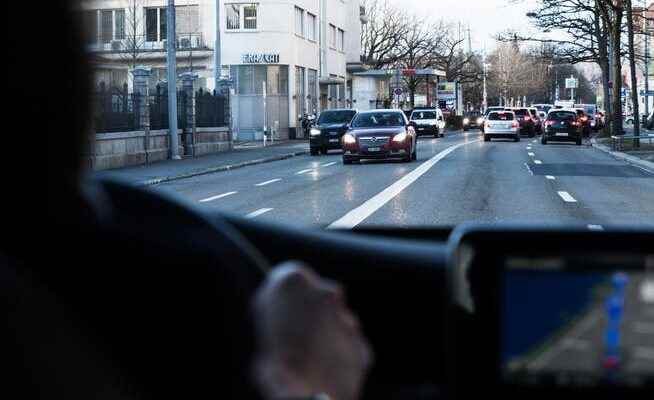The Zurich City Council is once again planning to temporarily remove lanes on Bellerivestrasse. His arguments remain tenuous.
Traffic jam on Bellerivestrasse: This is already a problem for many drivers today.
It is 2.5 kilometers long, four lanes wide and has for years been a provocation for the red-green city of Zurich with its bike fixity: Bellerivestrasse between Tiefenbrunnen and Utoquai.
The city’s car hunters contemptuously call the most important axis of access for the residents of the Gold Coast to Zurich “SUV slingshot”. For those who want to turn the city into a large meeting place, the street is the ultimate trophy, the capital stag. 25,000 vehicles use it every day.
The former AL city councilor Richard Wolff blew the halali two years ago. But his plans for removing tracks and bike paths were half-baked and communicated amateurishly. In the end he had to abort the test run; he passed the dossier on to his city council colleague Karin Rykart from the Green Party.
It is well known that Rykart is not a fan of cars either. It was to be feared that she would now try again to try traffic. The balance of power in red-green Zurich is too clear, and the lobby of those who advocate a sensible transport policy and allow cars their place on Zurich’s streets is too weak.
The positive at the beginning: Rykart’s attempt, which again provides for the temporary removal of two car lanes and bike paths on both sides, went better than Wolff’s. However, this is not very high art.
It is worth mentioning that the performance of the road is explicitly to be maintained this time. There should still be at least four car lanes at Bellevue and Tiefenbrunnen. The idea of a traffic light system is also good: if it turns out that the attempt leads to problems, it should first be adjusted and, if necessary, stopped completely.
The danger here, however, is that the criteria for aborting an exercise are set far too high. The emergency brake would have to be pulled immediately, not only in the case of an increase in traffic accidents, but also in the event of longer traffic jams and alternative traffic in the neighbourhood. Rykart promises to “disclose everything and hide nothing” during the experiment. You have to measure them by that – should the attempt really come about.
Because the fundamental question arises: Why is this test necessary at all? There are several studies and simulations that have dealt with the situation on Bellerivestrasse in depth. Wolff’s project was stopped mainly because the analyzes showed that a continuous reduction in lanes is not possible without impairing performance. It is questionable why this should be completely different with the communicated adjustments.
The new test run therefore seems like a constraint. What does not fit is made to fit. After numerous costly studies, another complex monitoring with interim and final reports is now being added. It is not clear why the experiment should then last a full nine months.
It is also doubtful that the situation for cyclists will improve significantly. There are already more pleasant routes for them, for example by the lake, on Mühlebachstrasse, Dufourstrasse or Seefeldstrasse. It should actually be obvious that the different road users should be separated wherever possible. Cycle paths are not needed everywhere.
It would be downright scandalous if the city wanted to push through the drastic attempt without the consent of the canton. The city would have bad arguments for this. When it came to the approval of a two-day folk festival on the Hardbrücke, the security department pointed out in the NZZ that it needed the approval of the canton police. This is because thoroughfares outside the urban area would be affected. What applies to the Hardbrücke for a weekend certainly applies to Bellerivestrasse for nine months.
It can be expected from the canton that in this matter it will not only take city dwellers’ requests for bicycles into account, but also the mobility needs of the agglomeration.
